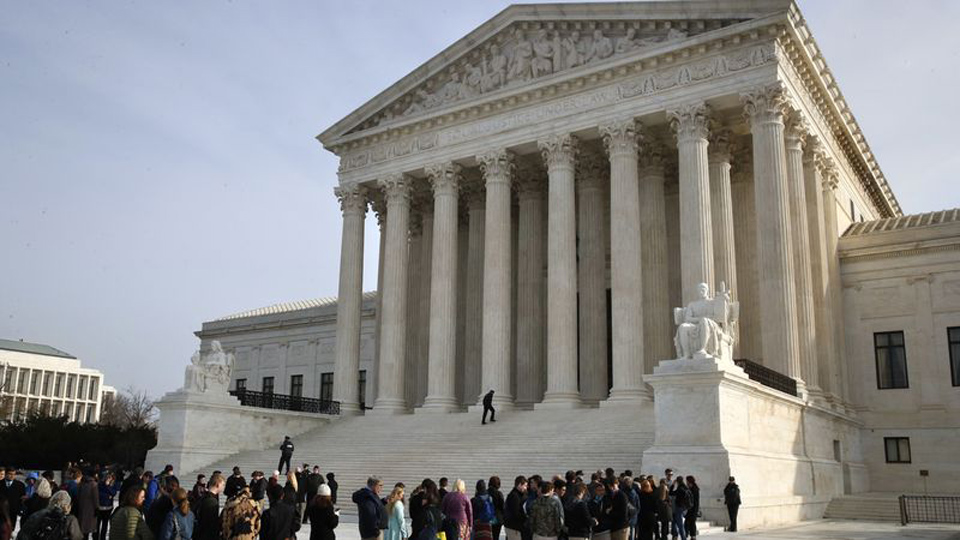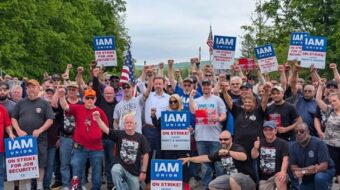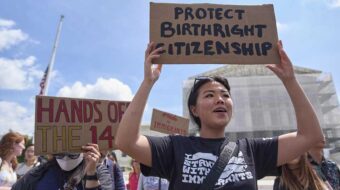
WASHINGTON—Bosses won and workers – especially non-union workers – lost when the 5-man GOP-named majority on the U.S. Supreme Court ruled mandatory arbitration trumps workers’ rights.
The case, decided on a 5-4 vote, also barred workers covered by mandatory arbitration clauses in their individual employment contracts from banding together as a class to sue to bosses when they find the bosses broke the pacts. Instead, the workers must confront the corporations one by one.
Three cases rolled into one, collectively named the Epic Systems case, mean that workers who sign pacts with such mandatory arbitration clauses “waive their rights to file for collective action” when the boss breaks the pacts, AFL-CIO Co-General Counsel Craig Becker said in a telephone interview.
Justice Neil Gorsuch wrote in the May 21 decision that although the Federal Arbitration Act generally requires courts to enforce arbitration agreements, one so-called “savings clause” in it was an exception: if the arbitration agreement breaks some other federal law.
GOP President Donald Trump named Gorsuch to the Supreme Court. Gorsuch is a proponent of originalism, the idea that the Constitution should be interpreted as perceived at the time of enactment, and of textualism, the idea that statutes should be interpreted literally, without considering the legislative history and underlying purpose of the law.
The workers involved cited that “savings clause” exception. They sued as classes, saying their firms either didn’t pay the minimum wage or overtime. Both non-payments break the Fair Labor Standards Act (FLSA). The bosses invoked their individual arbitration clauses, and the workers in class actions told lower courts that forced arbitration breaks their labor law rights under the National Labor Relations Act.
The National Labor Relations Act (NLRA) protects class actions, the workers said. Gorsuch and the court majority said “no.”
“Congress has instructed in the Arbitration Act that arbitration agreements providing for individualized proceedings must be enforced, and neither the savings clause nor the National Labor Relations Act suggests otherwise,” Gorsuch declared.
The case is important, especially for non-union workers, because it opens the door for employers to order forced arbitration virtually any time they want – and the workers are stuck. Numerous studies show bosses win 90 percent or more of all arbitration cases.
“No one who’s represented employers cannot say this will cripple enforcement of any labor laws, especially the FLSA,” Becker said.
With this ruling, “employers will know the court will protect them. Without class action suits, you’ll have much less effective enforcement of labor laws.”
Gorsuch wrote “the employees” in Epic Systems, at Murphy Oil and at the Ernst & Young accounting firm “ask the court to infer class and collective (legal) are ‘protected concerted activities’” under labor law’s key section 7. “But section 7 focuses on the right to organize unions and bargain collectively. It does not mention class or collective action procedures or even hint at a clear and manifest wish to displace the Arbitration Act. It is unlikely Congress wished to grant a right” to class actions “since those were hardly known when the NLRA was adopted in 1935.”
Gorsuch also noted section 7 sets up detailed regulations for “protected concerted activities” by workers which it lists in the NLRA – but none for class action suits. And the arbitration law’s “savings clause” covers only “obvious cases, such as fraud, duress and unconscionability.”
The dissenting opinion
Justice Ruth Bader Ginsburg, writing for the four dissenters, said the court majority is going back to the days before 1908 when the justices “regularly overrode legislative policy judgements.” Many of those destroyed policies were in workers’ favor.
“Congressional correction of the elevation of the Federal Arbitration Act over workers’ rights is urgently in order,” Ginsburg wrote. Otherwise, she warned, employers could even try to bring back the “yellow-dog contracts” that existed before 1935.
Those pacts banned workers from forming their own unions and banned other “protected concerted activities.” The NLRA outlawed them.
But Becker said union workers will by and large escape the damage from this High Court ruling, for now. “The one group still protected, and who can’t waive their rights to class actions, are those who are protected by unions,” he explained.
But that doesn’t minimize the anti-worker impact of the High Court’s ruling, he warned. That’s because this ruling could be magnified if the justices rule, by the end of July, that every single state and local government worker in the country could be a potential “free rider.”
The Janus case danger
Unions and workers widely expect the same 5-man GOP-named majority to rule against them in the Janus v AFSCME District Council 31 case, brought by the anti-worker anti-union National Right to Work Committee and its legal defense arm.
The RTW crowd and its recruited and paid-for worker, anti-union Illinois state employee Mark Janus, argue that anything unions do – even bargaining and enforcing contracts – is “political” and violates the anti-union workers’ free speech rights.
By turning every state and local government into a virtual “right to work” site, the court would deprive unions of tens of thousands of members – one analysis puts minimum losses at 726,000 nationwide – and tens of millions of dollars in “agency fees” they use to defend all workers.
“This is an ominous precursor of Janus,” Becker said. “Together, they’re the judicial equivalent of 1947 in Congress.” Back then, the GOP-run Congress passed the Taft-Hartley Act, over strong and outspoken union opposition and President Harry S. Truman’s veto. That law ushered in “right-to-work” laws and imposed draconian restrictions on workers’ rights thus seriously weakening the NLRA.











